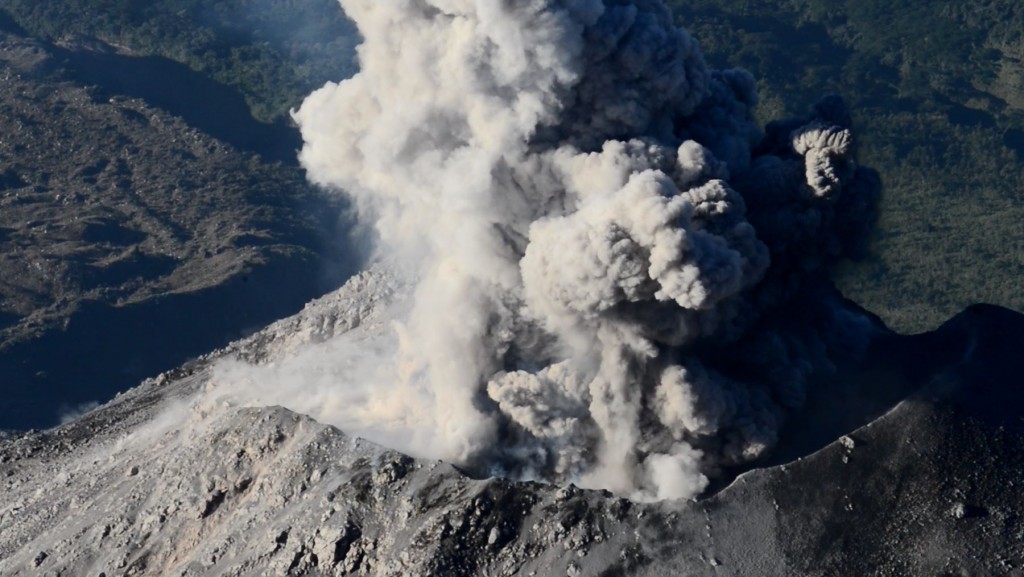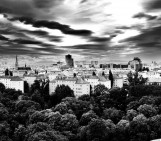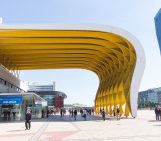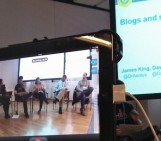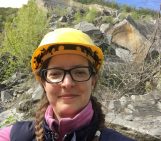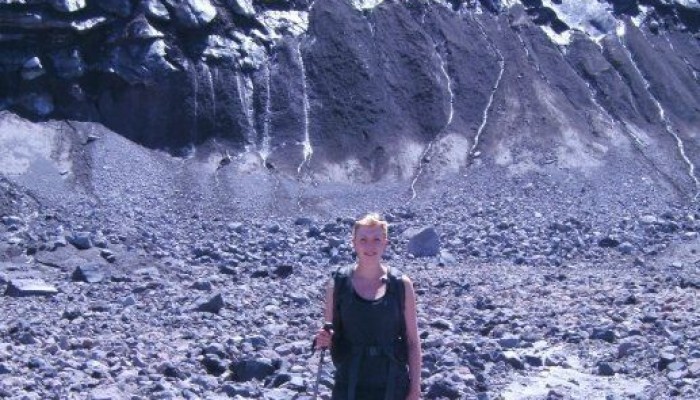
Geotalk is a regular feature highlighting early career researchers and their work. In this interview we speak to Jackie Kendrick, a volcanologist at the University of Liverpool, and winner of the 2016 GMPV Outstanding Young Scientist Award. The occasion will be marked during the upcoming General Assembly, where you’ll be able to listen to Jackie speak in session GMPV 1.1 on the topic of friction in volcanic environments.
First, could you introduce yourself and tell us a little more about your career path so far?
My name is Jackie Kendrick, and I’m a post-doc in volcanology at the University of Liverpool. I studied for an MSci in Geology at University College London, where I conducted my research project in the Rock and Ice Physics Laboratory. This was an insightful experience for me, I had always been passionate about volcanoes, but having the opportunity to work hands-on in a research environment taught me that I wanted to focus on a career an academia.
I then went on to an Internship at the USGS Cascades Volcano Observatory in Washington State (USA), where I worked on processing of seismic data and had the chance to do a huge amount of fieldwork in incredibly varied settings – for example I installed seismometers at Crater Lake, deployed rapid-response monitoring systems (termed spiders!) at Mount St. Helens and performed landslide simulations at a debris flow flume.
I then moved to Munich, where I undertook my PhD in the Department of Earth and Environmental Sciences at Ludwig Maximilian University. During my PhD I was fortunate enough to largely choose the direction of my studies, as such my research focused on lava dome eruptions from an integrated field, monitoring and experimental approach. Lava dome eruptions have always held a huge fascination for me, and their unpredictable behaviour, with rapid changes from effusive to explosive eruptions, continues to enthral the volcanological community. My PhD opened up possibilities I could not have imagined, and I visited breath-taking volcanic landscapes and state-of-the-art laboratories, where I met so many inspirational scientists – I knew the research community was something I could not turn my back on.
Upon completing my PhD in early 2013 I secured a post-doctoral position at University of Liverpool, funded by the European Research Council. During this position I have worked on a great variety of topics, including experimental studies of magma rheology, rock deformation and friction experiments as well as learning new volcano monitoring strategies like infrasound. Importantly, I have also helped design and develop bespoke high-temperature equipment for the rapidly growing Experimental Volcanology Laboratory, which has allowed me to target specific conditions not previously explored, and once again focus my attention toward the behaviour of dome-building volcanoes, which I find so dynamic in both activity and dormancy.
My primary goal in my research is to strive for the integration of multiple strategies, be it geophysics, geochemistry or geodynamics to try to better understand volcanological processes, and that’s something I hope to continue to pursue throughout my career.
During EGU 2016, you will receive the Outstanding Young Scientist Award from the GMPV Division for your work on understanding what role friction plays in volcanic eruptions. For instance, you’ve carried research out which tries to decipher what role the frictional properties of volcanic rocks and ash play in controlling the run-out distances, and associated risk, of pyroclastic density currents. Could you tell us a bit more about your research in this area and its importance?
This is something that I have really just started working on in the last year – it’s a new direction for me and that’s really exciting! To be recognised by the community, in receiving this award, is a great honour, and I do hope that I can continue to push frontiers with the research I undertake in the future.
This new endeavour into pyroclastic flows developed naturally, logically from work I was doing on sector collapse at volcanoes – where a volcano becomes unable to support its own weight and fails and collapses. We have just recently acquired the capability to study the frictional properties of rocks at high temperature, something which has been really lacking in volcanology previously, and so this opened up a whole realm of possible applications – one of which is looking at the dynamics of pyroclastic flows. Supported by colleagues at University of Liverpool, our approach is to constrain the frictional properties of a range of volcanic materials at realistic temperatures, for example, pyroclastic flows can reach several hundreds of degrees, even as high as 1000oC. The accurately constrained material properties that we get through laboratory experiments can then be integrated into models using accurate topography, which can predict for example, run-out distance, i.e. how far a flow will travel away from the volcano.
This type of study is hugely important at lava dome volcanoes especially, where pyroclastic flows can be triggered by even small collapse events on the lava dome or at lava flow fronts – events that may have no warning at all. Never has this been more apparent than standing on the lava dome at the summit of Mount Unzen (Japan), observing the precipitous drop to the small, vulnerable suburbs of Shimabara town, where tragically, 44 people lost their lives in a pyroclastic flow in 1991. Hopefully, via our efforts to accurately predict flow dynamics, as well as actively tackling real-time monitoring targeted directly at pyroclastic flows (currently underway at Santiaguito volcano, Guatemala), such tragedies can be avoided in future.
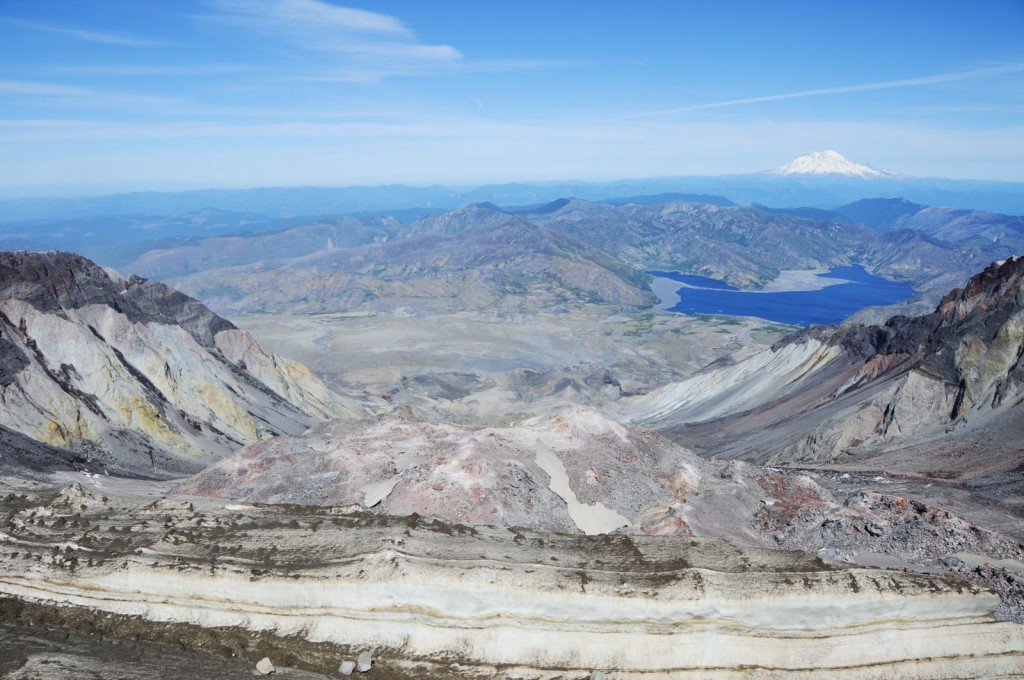
The view down over Mount St. Helens crater from the summit, in the centre the lava dome has grown in the collapse scar from the 1980 eruption. The collapse devastated the proximal land and vegetation, dead trees still float like matchsticks in the calm waters of Spirit Lake and the event left the inner workings of the volcano open to scrutiny. In the background, the glacier-capped Mount Rainier lies dormant. (Credit: Jackie Kendrick)
These approaches are also pertinent in understanding landslides and sector collapse events too – an interest of mine that was sparked during fieldwork at Mount St. Helens, which suffered one of the most infamous and catastrophic sector collapses ever documented in 1980.
It seems like Mount St. Helens has been a pretty inspirational place for you over the years! Can you tell us more about the work it’s stimulated?
Absolutely- I’ve been lucky enough to visit this spectacular volcano on numerous occasions, sometimes for work and always for pleasure!
My MSci research looked at the strength of rocks that make up the volcanic edifice rocks (usually layered lava flows that give volcanoes their familiar cone-shape), but the real defining moment in my career path was during fieldwork in 2010. During a visit organised between Ludwig Maximilian University of Munich, University College London, University of British Columbia and with the USGS we had the chance to study the crater lava domes up close for almost a week, to conduct thorough structural investigation of the internal lava dome characteristics. The domes, formed during eruptions in 1980-86 and 2004-08 are surrounded by the so-called Crater Glacier, which forms a ring around the domes, and which prevents access by foot – instead, we had to fly in by helicopter and camp in the crater!
There I began to appreciate lava domes for what they are, huge, rigid masses of near-solidified rock that are forced through the crust by buoyant magma below. This is especially true of Mount St. Helens, where the magma during the 2004-08 eruption was already crystallised at a depth of about 1 km and the dome is formed of a series of solid magma spines that rose up during the eruption, like arching whalebacks from the crater floor. These whalebacks are mantled by the products of friction, shear zones with powdery gouge, complex fracture networks and distorted crystals. It became suddenly apparent to me how important frictional processes were during these types of eruption, and how exciting it could be to push my research in a new direction endeavouring to understand it!
So since your career defining visit to Mount St. Helens in 2010, it’s been your goal to understand how frictional properties come into play in different volcanic scenarios, including the conduit?
Exactly, I’ve always had a passion for new and exciting research directions – and looking at the frictional properties of volcanic rocks in the context of erupting magma was something only touched upon experimentally before.
During an eruption, magma (called lava after it reaches the surface) is carried from the subterranean magma chamber to the surface in a conduit. Some conduit models have proposed a friction criteria to explain certain seismic signals, but parameters were derived theoretically or from friction experiments on other rocks. I started performing friction experiments in 2011. In these experiments 2 cylindrical rock cores are placed end-on, while a load (force) is applied from one end, and the other end is rotated at a desired velocity to create a simulated fault. I’ve looked at the frictional behaviour of volcanic glass, of ash, and of crystalline lavas – and I always try to integrate these studies with geophysical observations of real processes. You can watch one of these experiments in this video:
Another important aspect is examining microstructures and performing geochemical analysis, to make sure that the experiments recreate elements of natural examples. So far these investigations have led to a number of important findings:
- That the heat that can be generated by friction can be immense – just try rubbing your hands together for a few seconds and then imagine this process in magma(!)
- Volcanic rocks melt readily under friction – much more rapidly than most other rock types
- The heat generated by friction can make the magma degas – volatiles in magma are only stable under certain pressure-temperature conditions, and if rapidly changed the gas will try to escape – we term this thermal vesiculation, and cite it as the driving force of some explosive eruptions
- When some lavas melt due to friction, the viscosity (stickiness) of the melt is abnormally high – this melt “glues” the slip zone together (a phenomena called viscous braking) and it can actually control the rate of an eruption.
The list goes on, and there are many applications beyond the conduit, in terms of volcanoes, faults and even material sciences. But even after several years, nothing beats the excitement of seeing a molten magma form between volcanic rocks rubbed together for just a fraction of a second!
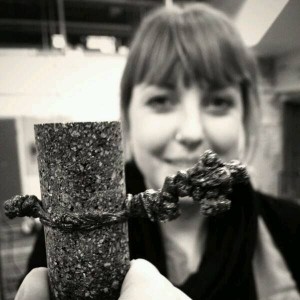
The product of our first successful friction experiment at University of Liverpool in 2014 – we created frictional melt in a pair of andesites from Volcán de Colima (Mexico). (Credit: Jackie Kendrick)
We can’t argue, volcanoes are possibly one of the coolest things in the Earth sciences, but what about them sparked your interest and the willingness to dedicate your research to them? In particular, why did you choose this interdisciplinary field at the crossroads between structural geology, seismology and volcanology?
For me, volcanoes hold such intrigue because of the power they possess – the unharnessed raw energy expelled during an eruption is something just fascinating to watch. The fact that they hold the potential to wreak havoc, and that we don’t yet really understand all the processes involved, just adds to my desire to study them, to know them inside and out.
There’s no doubt in my mind that this can be best achieved using an interdisciplinary approach, it’s all about monitoring, detailing and simulating the process. That is, we see something in real-time via geophysics, we simplify the system so that we can explore individual processes experimentally, and then we integrate our findings back into models to see if we can recreate a phenomena – there’s no point explaining one aspect if it can’t tie in all the others.
Fortunately I’ve had a pretty varied background, nonetheless it’s impossible to be an expert at everything – only highlighting the need to work together, to integrate knowledge from different fields in order to start deciphering complex earth processes.
This was the goal of the recent NSF-funded Workshop on Volcanoes 2016, held at Quetzaltenango (Guatemala), near the ever-active Santiaguito volcano, where we shared best practices and methodologies in monitoring and research – something I believe should be at the forefront of our minds moving forward.
To finish, what advice would you give students fascinated by volcanoes wanting to pursue a career in academia studying volcanology?
Well, first off, I’d say go for it! There are so many great post-graduate options nowadays, and you can really go down any route you choose – be it remote monitoring (like InSAR), proximal monitoring (including seismicity, gas measurements), laboratory experiments (such as friction described here) or you can approach volcanology from the social sciences, looking at influences on people and the environment. There are so many ways that you can get into volcanology, and what’s important is drive and passion, more than a specific academic prerequisite.
That said, I would certainly advise getting some experience before committing to post-graduate study, not least to find out exactly where your interests lie! You can get involved in monitoring by volunteering at volcano observatories, or in research by contacting professors and other academics for short internships and research opportunities. If you’re still doing your undergraduate studies, ask around, speak to graduate students to get advice and learn about the options open to you, and if you can, go to conferences, they are excellent for meeting influential people that can help shape your career!

